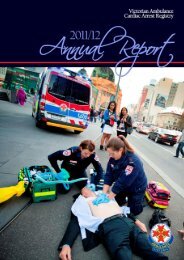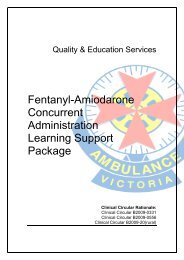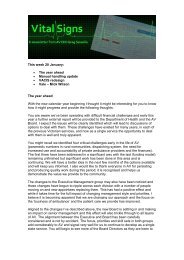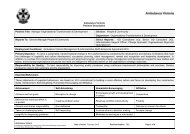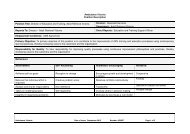AMBULANCE VICTORIA STRATEGIC PLAN 2010 â 2012
AMBULANCE VICTORIA STRATEGIC PLAN 2010 â 2012
AMBULANCE VICTORIA STRATEGIC PLAN 2010 â 2012
Create successful ePaper yourself
Turn your PDF publications into a flip-book with our unique Google optimized e-Paper software.
5. The Planning Environment<br />
Eleven key challenges have been identified, which AV will need to address<br />
during the planning period and beyond.<br />
Increasing demand for services<br />
Ambulance services in Victoria have been under stress as a result of continuing<br />
strong growth in demand for more than a decade. Since 1999-2000, ambulance<br />
caseload in Victoria has grown by an average of 5.7 per cent per annum, with<br />
both emergency and non-emergency incidents increasing by more than 50 per<br />
cent. Other ambulance services around the world are experiencing similar<br />
demand pressures.<br />
Demand management has been an important focus for more than five years.<br />
The referral system for lower priority 000 callers in Melbourne has played an<br />
important role in controlling demand, with more than 7 per cent of callers not<br />
receiving an emergency ambulance dispatch. There is scope for expansion<br />
of the service and exploration of new emergency demand management<br />
initiatives. Management of non-emergency demand, and ensuring<br />
appropriate allocation of resources to meet patient needs will also be a<br />
priority. These strategies will assist in moderating growth, but increasing<br />
demand is expected to remain a key challenge through the planning period.<br />
The drivers of ambulance demand are similar to those affecting demand for most<br />
other health services. These include demographic change (ageing and population<br />
growth), which accounts for about 25 per cent of the increase in emergency<br />
demand. Trends in the health of the community play a key role, notably the<br />
increasing burden of chronic disease. Other factors also include changes in<br />
medical practice and patient management (e.g. the trend to early discharge<br />
and treatment in the community), social changes (e.g. the increasing number of<br />
people living alone), reduced accessibility to other health services in some areas<br />
(especially general practitioners) and rising community expectations.<br />
Growth has slowed in the last eighteen months, but there is no reason to believe<br />
that the long-term trend has changed. Large numbers of seriously ill patients<br />
(about 40 per cent of triage category 1 to 3 patients in Melbourne) are not<br />
transported to hospital emergency departments by ambulance, indicating there<br />
is significant potential for further increases in demand.<br />
3





